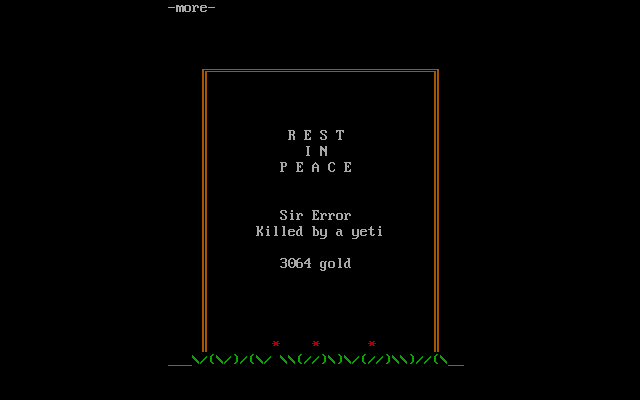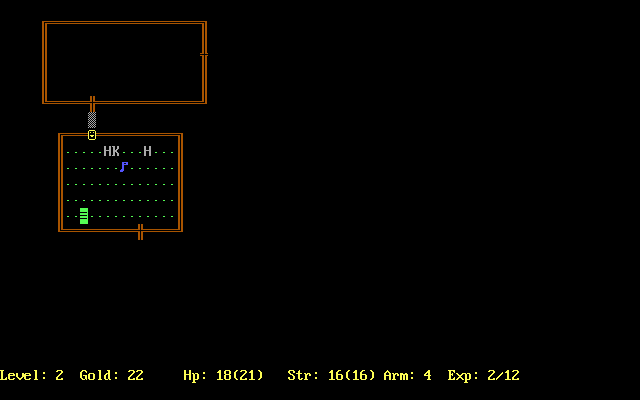Retro Replay Review
Gameplay
Rogue Clone stays true to its roots by delivering a classic dungeon-crawling experience driven by procedurally generated levels. Every descent into the dungeon feels fresh, as corridors twist unpredictably and room layouts ensure no two runs are ever alike. Players will bash monsters, collect treasures and search for the legendary Amulet of Yendor, all while managing inventory and hit points in tense, turn-based combat.
(HEY YOU!! We hope you enjoy! We try not to run ads. So basically, this is a very expensive hobby running this site. Please consider joining us for updates, forums, and more. Network w/ us to make some cash or friends while retro gaming, and you can win some free retro games for posting. Okay, carry on 👍)
One of the standout features in Rogue Clone is its accessibility compared to the original UNIX Rogue. With no dark rooms to hinder exploration and a slightly gentler difficulty curve, new roguelike enthusiasts can get a foothold without the punishing learning curve of early roguelikes. Monsters spawn more frequently, but the abundance of items and automatic identification of unknown gear after first use helps offset this more aggressive enemy behavior.
Though the first release omits traps and secret doors, later versions introduce these elements—albeit with forgiving mechanics such as occasional trap malfunctions—adding layers of surprise without overwhelming newcomers. Maze generation has also been tweaked for clarity, making it easier to navigate the labyrinthine halls. Combined, these modifications create a streamlined gameplay loop that retains the addictive “one more level” pull of the original Rogue.
Graphics
Rogue Clone embraces its ASCII heritage without apology. Every tile, monster and item is represented by a single character, conjuring the dungeon’s mood purely through text. While modern gamers may balk at the absence of sprites or polygonal models, veterans will appreciate the stark clarity of simple symbols on a monochrome or color terminal.
The choice of ASCII art is not merely nostalgic—it’s functional. With only characters and colors to render, the game runs smoothly on the most modest UNIX systems, requiring negligible memory and processing power. This minimalism ensures split-second responsiveness in combat and exploration, which is critical when a horde of goblins is closing in.
Despite its austere presentation, Rogue Clone uses color sparingly to distinguish items, monsters and dungeon features. A glowing “!,” for example, might instantly signal a potion, while a bright red “D” warns of a demon’s presence. This restrained palette enhances readability and keeps the focus firmly on strategy and discovery rather than visual spectacle.
Story
At its core, Rogue Clone shares the simple yet compelling narrative of its ancestor: delve deep into a hostile dungeon, retrieve the fabled Amulet of Yendor and escape with your life. This straightforward objective provides context without overwhelming the gameplay, letting players project their own hero’s tale onto the ASCII battleground.
Though the game offers no animated cutscenes or voiced dialogue, it crafts its lore through in-game messages and item descriptions. Every scroll read and every potion quaffed adds to a patchwork story of magical artefacts, tragic adventurers and lurking horrors. The sparse storytelling is perfectly suited to the text-only interface, inviting players to imagine the epic behind each display of “You see here a shimmering ring.”
Rogue Clone’s narrative simplicity is also its strength—there is no hand-holding or forced plot twists. Instead, each playthrough weaves an emergent saga of triumphs, narrow escapes and, all too often, grisly failures. The lack of a heavyweight plot encourages repeated runs, with each new character motivated by the promise of finally unearthing the Amulet of Yendor.
Overall Experience
Rogue Clone offers a pure, unadulterated roguelike experience that remains as compelling today as it was in 1986. Its blend of procedural levels, ASCII graphics and permadeath mechanics delivers a high-stakes adventure that rewards careful planning, quick thinking and a bit of luck. For players seeking a taste of gaming history or a hardcore dungeon crawl, Rogue Clone does not disappoint.
The game’s streamlined modifications—automatic item identification, fewer dark rooms and a slightly gentler difficulty—strike an excellent balance between authenticity and approachability. While hardcore fans of the original Rogue may miss certain features (like guaranteed trap activation or secret doors), most newcomers will appreciate the reduced frustration and more forgiving learning curve.
Ultimately, Rogue Clone is more than a museum piece: it’s a testament to the enduring appeal of emergent gameplay and text-based immersion. Whether you’re a longtime roguelike enthusiast or a curious newcomer, take this clone for a spin in your UNIX terminal. Just remember: in the depths below, death may come swiftly, but so too does the thrill of discovery and the drive to try once more.
 Retro Replay Retro Replay gaming reviews, news, emulation, geek stuff and more!
Retro Replay Retro Replay gaming reviews, news, emulation, geek stuff and more!









Reviews
There are no reviews yet.